Wai-Fah Chen.The Civil Engineering Handbook
Подождите немного. Документ загружается.


18-10 The Civil Engineering Handbook, Second Edition
of discharge through the section Q and the head loss (h = 16 ft) must be constant. If the flow region
is saturated, it follows that the two impervious boundaries are streamlines and their difference must be
identically equal to the discharge quantity
From among the infinite number of possible streamlines between the impervious boundaries, we
sketch only a few, specifying the same quantity of flow between neighboring streamlines. Designating N
f
as the number of flow channels, we have, from above,
1
Similarly, from among the infinite number of possible equipotential lines between headwater and
tailwater boundaries, we sketch only a few and specify the same drop in head, say, Dh, between adjacent
equipotential lines. If there are N
e
equipotential drops along each of the channels,
(18.24)
If, now, we also require that the ratio Dw/Ds be the same at all points in the flow region, for convenience,
and because a square is most sensitive to visual inspection, we take this ratio to be unity,
and obtain
(18.25)
Recalling that Q, k, and h are all constants, Eq. (18.25) demonstrates that the resulting construction,
with the obvious requirement that everywhere in the flow domain streamlines and equipotential lines
meet at right angles, will yield a unique value for the ratio of the number of flow channels to the number
of equipotential drops, N
f
/N
e
. In Fig. 18.8 we see that N
f
equals about 5 and N
e
equals 16; hence, N
f
/N
e
=
5/16.
The graphical technique of constructing flow nets by sketching was first suggested by Prasil [1913]
although it was developed formally by Forchheimer [1930]; however, the adoption of the method by
engineers followed Casagrande’s classic paper in 1940. In this paper and in the highly recommended flow
nets of Cedergren [1967] are to be found some of the highest examples of the art of drawing flow nets.
Harr [1962] also warrants a peek!
Unfortunately, there is no “royal road” to drawing a good flow net. The speed with which a successful
flow net can be drawn is highly contingent on the experience and judgment of the individual. In this
regard, the beginner will do well to study the characteristics of well-drawn flow nets: labor omnia vincit.
In summary, a flow net is a sketch of distinct and special streamlines and equipotential lines that preserve
right-angle intersections, satisfy the boundary conditions, and form curvilinear squares.
2
The following
procedure is recommended:
1
There is little to be gained by retaining the approximately equal sign ª.
2
We accept singular squares such as the five-sided square at point H in Fig. 18.8 and the three-sided square at
point G. (It can be shown — Harr [1962], p. 84 — that a five-sided square designates a point of turbulence). With
continued subdividing into smaller squares, the deviations, in the limit, act only at singular points.
Q
y
BGHC
y
EF
–=
QN
f
QD kN
f
wD
sD
-------
hD==
hN
e
h and QD k
N
f
N
e
------
wD
sD
-------
h==
wD
sD
------- 1=
Qk
N
f
N
e
------
h=
© 2003 by CRC Press LLC
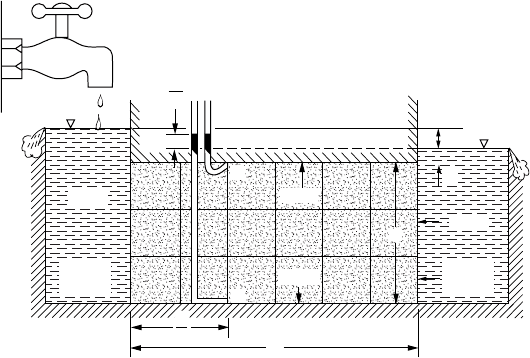
Groundwater and Seepage 18-11
1. Draw the boundaries of the flow region to a scale so that all sketched equipotential lines and
streamlines terminate on the figure.
2. Sketch lightly three or four streamlines, keeping in mind that they are only a few of the infinite
number of possible curves that must provide a smooth transition between the boundary streamlines.
3. Sketch the equipotential lines, bearing in mind that they must intersect all streamlines, including
boundary streamlines, at right angles and that the enclosed figures must form curvilinear rectan-
gles (except at singular points) with the same ratio of Ds/Ds along a flow channel. Except for partial
flow channels and partial head drops, these will form curvilinear squares with Dw = Ds.
4. Adjust the initial streamlines and equipotential lines to meet the required conditions. Remember
that the drawing of a good flow net is a trial-and-error process, with the amount of correction
being dependent upon the position selected for the initial streamlines.
Example 18.1
Obtain the quantity of discharge, Q/kh, for the section shown in Fig. 18.9.
Solution. This represents a region of horizontal flow with parallel horizontal streamlines between the
impervious boundaries and vertical equipotential lines between reservoir boundaries. Hence the flow net
will consist of perfect squares, and the ratio of the number of flow channels to the number of drops will
be N
f
/N
e
= a/L and Q/kh = a/L.
Example 18.2
Find the pressure in the water at points A and B in Fig. 18.9.
Solution. For the scheme shown in Fig. 18.9, the total head loss is linear with distance in the direction
of flow. Equipotential lines are seen to be vertical. The total heads at points A and B are both equal to
2h/3 (datum at the tailwater surface). This means that a piezometer placed at these points would show
a column of water rising to an elevation of 2h/3 above the tailwater elevation. Hence, the pressure at
each point is simply the weight of water in the columns above the points in question: p
A
= (2h/3 + h
1
)g
w
,
p
B
= (2h/3 + h
l
+ a)g
w
.
Example 18.3
Using flow nets obtain a plot of Q/kh as a function of the ratio s/T for the single impervious sheetpile
shown in Fig. 18.10(a).
FIGURE 18.9 Example of flow regime.
2
h
3
h
h
= 0
Coarse
screen
a
y =
Q
y = 0
A
B
Coarse
screen
h
=
h
L
L
3
h
1
© 2003 by CRC Press LLC
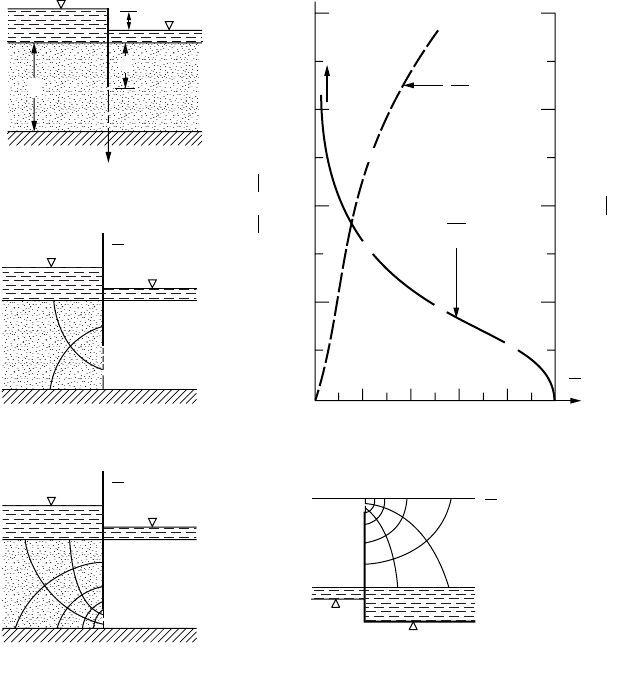
18-12 The Civil Engineering Handbook, Second Edition
Solution. We first note that the section is symmetrical about the y axis, hence only one-half of a flow
net is required. Values of the ratio s/T range from 0 to 1, with 0 indicating no penetration and 1 complete
cutoff. For s/T = 1, Q/kh = 0 [see point a in Fig. 18.10(b)]. As the ratio of s/T decreases, more flow
channels must be added to maintain curvilinear squares and, in the limit as s/T approaches zero, Q/kh
becomes unbounded [see arrow in Fig. 18.10(b)]. If s/T = 1/2 [Fig. 18.10(c)], each streamline will
evidence a corresponding equipotential line in the half-strip; consequently, for the whole flow region,
N
f
/N
e
= 1/2 for s/T = 1/2 [point b in Fig. 18.10(b)]. Thus, without actually drawing a single flow net, we
have learned quite a bit about the functional relationship between Q/kh and s/T. If Q/kh was known for
s/T = 0.8 we would have another point and could sketch, with some reliability, the portion of the plot
in Fig. 18.10(b) for s/T ≥ 0.5. In Fig. 18.10(d) is shown one-half of the flow net for s/T = 0.8, which yields
the ratio of N
f
/N
e
= 0.3 [point c in Fig. 18.10(b)]. As shown in Fig. 18.10(e), the flow net for s/T = 0.8
can also serve, geometrically, for the case of s/T = 0.2, which yields approximately N
f
/N
e
= 0.8 [plotted
as point d in Fig. 18.10(b)]. The portion of the curve for values of s/T close to 0 is still in doubt. Noting
that for s/T = 0, kh/Q = 0, we introduce an ordinate scale of kh/Q to the right of Fig. 18.10(b) and locate
on this scale the corresponding values for s/T = 0, 0.2, and 0.5 (shown primed). Connecting these points
(shown dotted) and obtaining the inverse, Q/kh, at desired points, the required curve can be had.
A plot giving the quantity of discharge (Q/kh) for symmetrically placed pilings as a function of depth
of embedment (s/T ), as well as for an impervious structure of width (2b/T ), is shown in Fig. 18.11. This
plot was obtained by Polubarinova-Kochina [1962] using a mathematical approach. The curve labeled
b/T = 0 applies for the conditions in Example 18.3. It is interesting to note that this whole family of
FIGURE 18.10 Example 18.3.
0 0.2 0.4 0.6 0.8 1.0
2.0
1.5
1.0
0.5
2.0
1.5
1.0
0.5
+b′
d
b
a
c
to ∞
+
+
+
kh
Q
curve
Q
kh
curve
s
T
= 0.2
s
T
= 0.8
s
T
= 0.5
s
T
Q
kh
N
f
Ne
=
Kh
Q
h
x
y
(
a
)
(
c
)
(
d
)
(
e
)
(
b
)
+ d′
T
s
© 2003 by CRC Press LLC
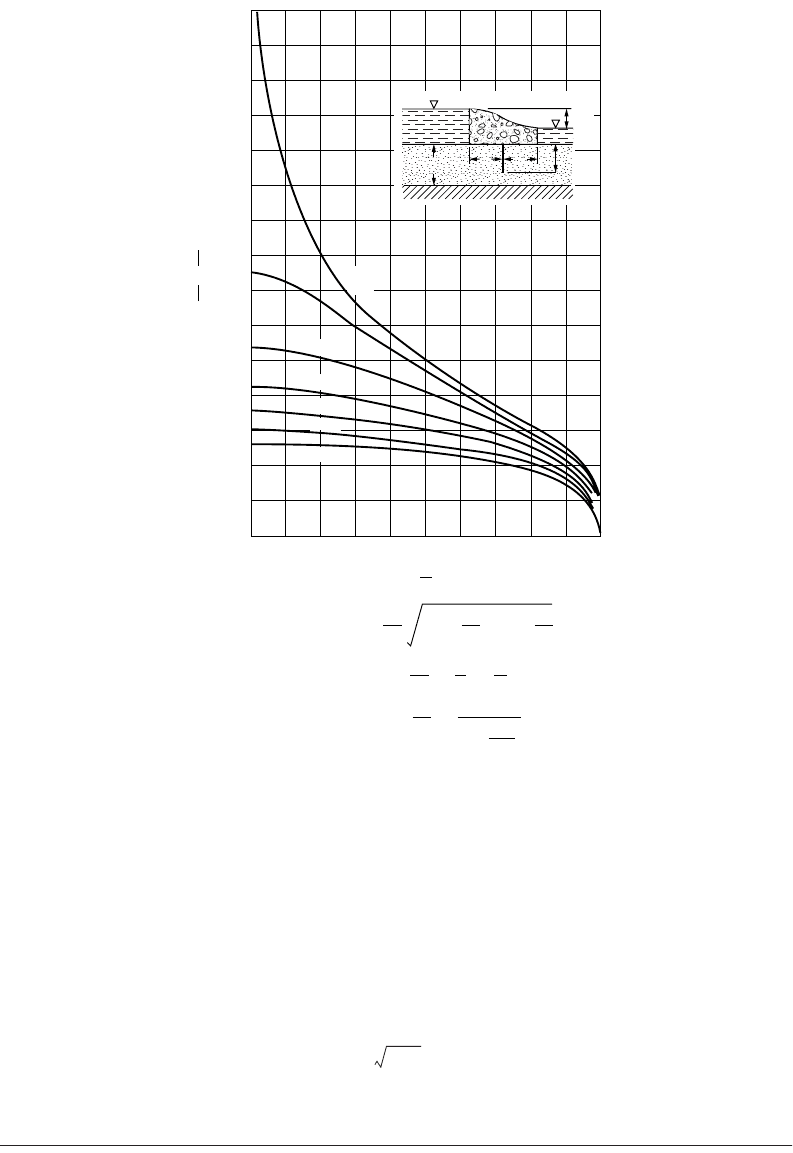
Groundwater and Seepage 18-13
curves can be obtained, with reasonable accuracy (at least commensurate with the determination of the
coefficient of permeability, k), by sketching only two additional half flow nets (for special values of b/T ).
It was tacitly assumed in the foregoing that the medium was homogeneous and isotropic (k
x
= k
y
).
Had isotropy not been realized, a transformation of scale (with x and y taken as the directions of maximum
and minimum permeability, respectively) in the y direction of Y = y(k
x
/k
y
)
1/2
or in the x direction of X =
x(k
y
/k
x
)
1/2
would render the system as an equivalent isotropic system [for details, see Harr, 1962, p. 29].
After the flow net has been established, by applying the inverse of the scaling factor, the solution can be
had for the anisotropic system. The quantity of discharge for a homogeneous and anisotropic section is
(18.26)
18.4 Method of Fragments
In spite of its many uses, a graphical flow net provides the solution for a particular problem only. Should
one wish to investigate the influence of a range of characteristic dimensions (such as is often the case in
FIGURE 18.11 Quantity of flow for given geometry.
1.5
1.4
1.3
1.2
1.1
1.0
0.9
0.8
0.7
0.6
0.5
0.4
0.3
0.2
0.1
0 0.1 0.2 0.3 0.4 0.5 0.6 0.7 0.8 0.9 1.0
b
/
T
= 0
0.25
0.50
0.75
1.00
1.25
1.50
T
bb
s
If
m
= cos
tanh
2
+ tan
2
p
s
2
T
s
T
π
b
2
T
π
s
2
T
Q
kh
4
m
1
p
for
m
≤ 0.3, = In
Q
kh
1-
m
2
16
−π
for
m
2
≤ 0.9, =
2 In
( )
Q
kh
1
2Φ
=
h
Qk
x
k
y
h
N
f
N
e
------
=
© 2003 by CRC Press LLC
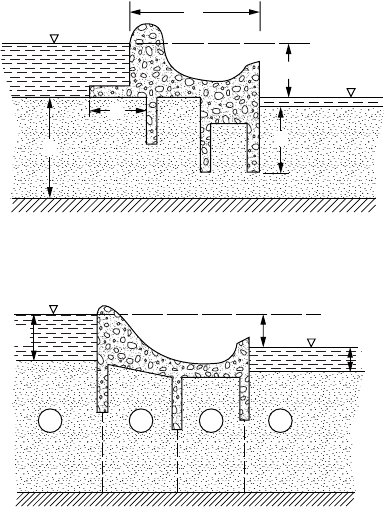
18-14 The Civil Engineering Handbook, Second Edition
a design problem), many flow nets would be required. Consider, for example, the section shown in
Fig. 18.12, and suppose we wish to investigate the influence of the dimensions A, B, and C on the
characteristics of flow, all other dimensions being fixed. Taking only three values for each of these
dimensions would require 27 individual flow nets. As noted previously, a rough flow net should always
be drawn as a check. In this respect it may be thought of as being analogous to a free-body diagram in
mechanics, wherein the physics of a solution can be examined with respect to satisfying conditions of
necessity.
An approximate analytical method of solution, directly applicable to design, was developed by Pav-
lovsky in 1935 [Pavlovsky, 1956] and was expanded and advanced by Harr [1962, 1977]. The underlying
assumption of this method, called the method of fragments, is that equipotential lines at various critical
parts of the flow region can be approximated by straight vertical lines (as, for example, the dotted lines
in Fig. 18.13) that divide the region into sections or fragments. The groundwater flow region in Fig. 18.13
is shown divided into four fragments.
Suppose, now, that one computes the discharge in the ith fragment of a structure with m such fragments
as
(18.27)
where h
i
is the head loss through the ith fragment and F
i
is the dimensional form factor in the ith fragment,
F
i
= N
e
/N
f
in Eq. (18.25). Then, as the discharge through all fragments must be the same,
whence
FIGURE 18.12 Example of complicated structure.
FIGURE 18.13 Four fragments.
B
h
C
T
A
1234
h
h
1
h
2
Q
kh
i
F
i
-------=
Q
kh
1
F
1
--------
kh
2
F
2
--------
kh
i
F
i
------- L
kh
m
F
m
---------=====
h
i
Â
Q
k
----
F
i
Â
=
© 2003 by CRC Press LLC
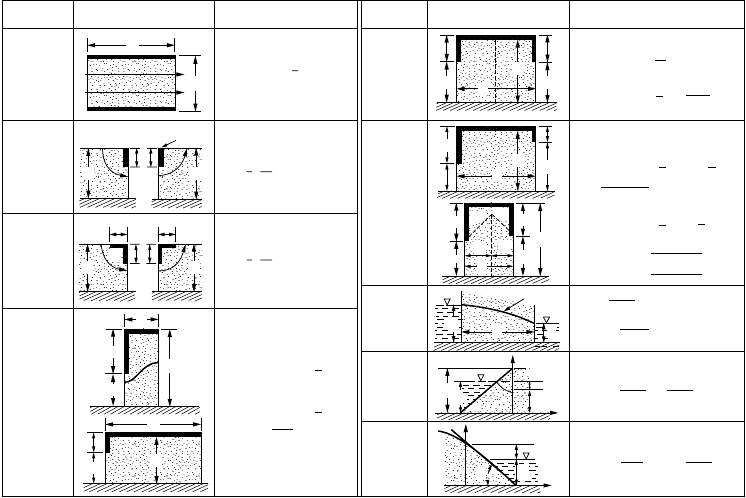
Groundwater and Seepage 18-15
and
(18.28)
where h (without subscript) is the total head loss through the section. By similar reasoning, the head
loss in the ith fragment can be calculated from
(18.29)
Thus, the primary task is to implement this method by establishing a catalog of form factors. Following
Pavlovsky, the various form factors will be divided into types. The results are summarized in tabular
form, Fig. 18.14, for easy reference. The derivation of the form factors is well documented in the literature
[Harr 1962, 1977].
Various entrance and emergence conditions for type VIII and IX fragments are shown in Fig. 18.15.
Briefly, for the entrance condition, when possible the free surface will intersect the slope at right angles.
However, as the elevation of the free surface represents the level of available energy along the uppermost
streamline, at no point along the curve can it rise above the level of its source of energy, the headwater
elevation. At the point of emergence the free surface will, if possible, exit tangent to the slope [Dachler,
1934]. As the equipotential lines are assumed to be vertical, there can be only a single value of the total
head along a vertical line, and, hence, the free surface cannot curve back on itself. Thus, where unable
to exit tangent to a slope, it will emerge vertical.
To determine the pressure distribution on the base of a structure (such as that along C ¢CC ¢¢) in
Fig. 18.16, Pavlovsky assumed that the head loss within the fragment is linearly distributed along the
impervious boundary. Thus, in Fig. 18.16, if h
m
is the head loss within the fragment, the rate of loss along
E¢C ¢CC ¢¢E ¢¢ will be
FIGURE 18.14 Summary of fragment types and form factors.
Fragment
type
Fragment
type
I
II
III
IV
IX
VIII
VII
VI
V
Illustration Illustration
L
a
E
bb
s
s
b
b
s
s
a
a
T
T
T
T
L
L
L
L
A
T
T
T
T
T
s
s''
s''
b''
b'
a''
a''
h
2
h
2
h
1
a
1
a
2
h
d
h
x
x
y
y
h
1
a'
s'
s'
s
aa
45°
Streamline
45°
α
β
Q
=
k
(1 + In )
a
2
a
2
a
2
+
h
2
cotβ
(1 + )
b
a
Q
=
k
In
h
1
−
h
h
d
−
h
h
d
cot α
Q
=
k
h
2
1
−
h
2
2
2
L
Φ =
h
1
+
h
2
2
L
Φ = In
kh
Q
1
2
Φ =
(1 +
)
s
a
+
b
−
s
T
Φ = In
Form factor, Φ (
h
is head
loss through fragment)
Form factor, Φ (
h
is head
loss through fragment)
L
≤ 2
s
:
Φ = 2 In (1 + )
L
2
a
L
− 2
s
T
L
≥ 2
s
:
Φ = 2 In (1 + ) +
b
≤
s
:
b
≥
s
:
s
a
L
≥
s
′ +
s
′′:
Φ = In [(1 + ) +
s
′
a
′
L
−
(
s
′ +
s
′′)
T
(1 + )]
s
′′
a
′′
( ), Fig. 17.11
kh
Q
1
2
Φ =
Φ =
( ), Fig. 17.11
L
a
+
L
≤
s
′ +
s
′′:
Φ = In [(1 + )
b
′
a
′
b
′
L
+
(
s
′ −
s
′′)
2
(1 + )]
b
′′
a
′′
b
′′
L
−
(
s
′ −
s
′′)
2
where
=
=
Qk
h
S
i 1=
m
F
i
-------------------
=
h
i
hF
i
SF
----------=
© 2003 by CRC Press LLC
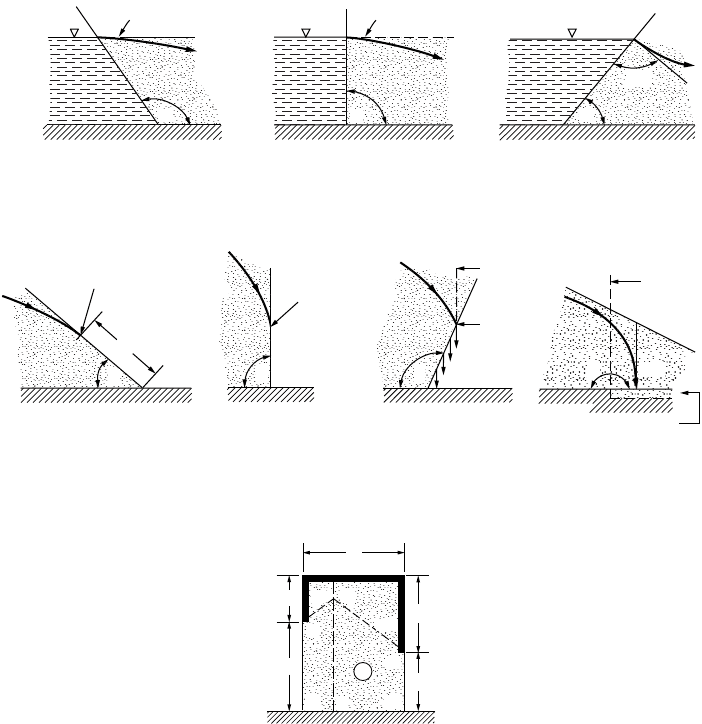
18-16 The Civil Engineering Handbook, Second Edition
(18.30)
Once the total head is known at any point, the pressure can easily be determined by subtracting the
elevation head, relative to the established (tailwater) datum.
Example 18.4
For the section shown in Fig. 18.17(a), estimate (a) the discharge and (b) the uplift pressure on the base
of the structure.
Solution. The division of fragments is shown in Fig. 18.17. Regions 1 and 3 are both type II fragments,
and the middle section is of type V with L = 2s. For regions 1 and 3, we have, from Fig. 17,11, with b/T =
0, F
1
= F
3
= 0.78.
For region 2, as L = 2s, F
2
= 2 ln (1+18/36) = 0.81. Thus, the sum of the form factors is
and the quantity of flow (Eq. 18.28) is Q/k = 18/2.37 = 7.6 ft.
FIGURE 18.15 Entrance and emergence conditions.
FIGURE 18.16 Illustration of Eq. (18.30).
Horizontal Horizontal
Tangent
Tangent
Vertical
Vertical
Drain
Tangent
to
vertical
Surface
of seepage
β < 90°β = 90°β > 90°
α > 90°α = 90°α < 90°
β = 180°
β
β
β
β
αα α′
90°
90°
(
a
)
(
b
)
s
′
s
′′
a
′
C′ C
L
a
′′
C′′
m
O′
E′
45°
O′′
E′′
N
F
0
45°
R
h
m
Ls¢ s≤++
------------------------=
F
Â
0.78 0.81 0.78++ 2.37==
© 2003 by CRC Press LLC
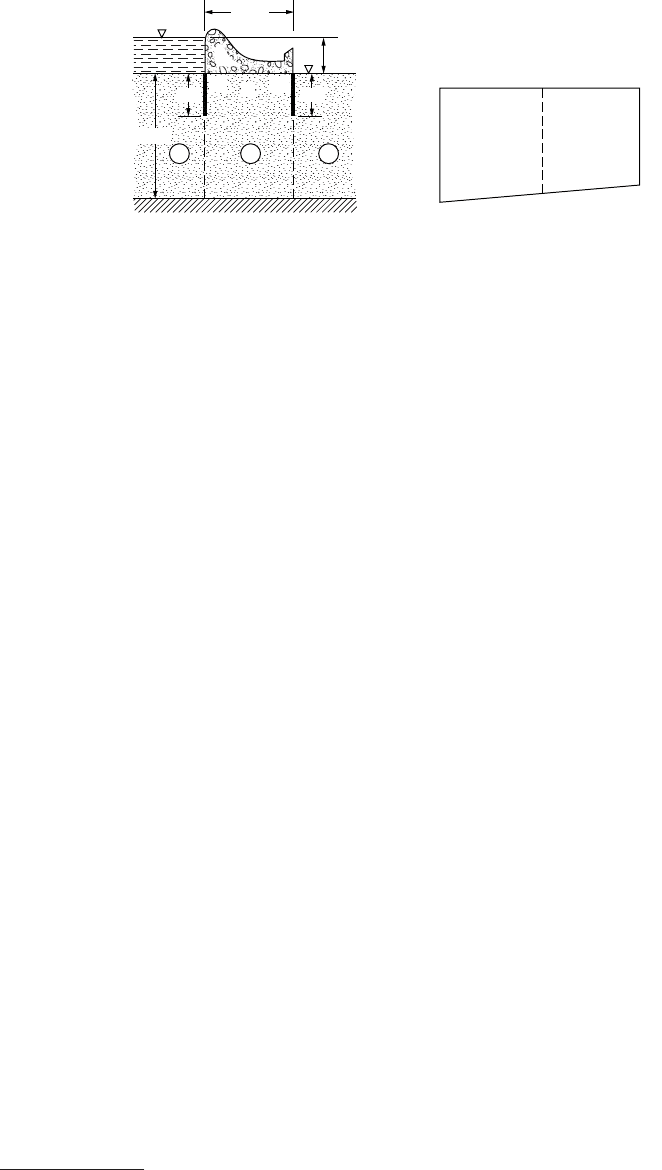
Groundwater and Seepage 18-17
For the head loss in each of the sections, from Eq. (18.29) we find
Hence the head loss rate in region 2 is (Eq. 18.30)
and the pressure distribution along C ¢CC ¢¢ is shown in Fig. 18.17(b).
Example 18.5
3
Estimate the quantity of discharge per foot of structure and the point where the free surface begins under
the structure (point A) for the section shown in Fig. 18.18(a).
Solution. The line AC in Fig. 18.18(a) is taken as the vertical equipotential line that separates the flow
domain into two fragments. Region 1 is a fragment of type III, with the distance B as an unknown quantity.
Region 2 is a fragment of type VII, with L = 25 – B, h
1
= 10 ft, and h
2
= 0. Thus, we are led to a trial-and-
error procedure to find B. In Fig. 18.18(b) are shown plots of Q/k versus B/T for both regions. The common
point is seen to be B = 14 ft, which yields a quantity of flow of approximately Q = 100k/22 = 4.5k.
Example 18.6
Determine the quantity of flow for 100 ft of the earth dam section shown in Fig. 18.19(a), where k =
0.002 ft/min.
Solution. For this case, there are three regions. For region 1, a type VIII fragment h
1
= 70 ft, cot a = 3,
h
d
= 80 ft, produces
(18.31)
For region 2, a type VII fragment produces
(18.32)
FIGURE 18.17 Example 18.4.
3
For comparisons between analytical and experimental results for mixed fragments (confined and unconfined
flow) see Harr and Lewis [1965].
18 ft
18 ft
27 ft
9 ft
9 ft
C′ C′′
C
12 3
C′ CC′′
10.6g
w
9.0g
w
7.5g
w
(
a
)
(
b
)
h
1
h
3
0.78
2.37
----------
18() 5.9 ft== =
h
2
6.1ft=
R
6.1
36
------- 17%==
Q
k
----
70 h–
3
--------------
80
80 h–
--------------
ln=
Q
k
----
h
2
a
2
2
–
2L
---------------=
© 2003 by CRC Press LLC
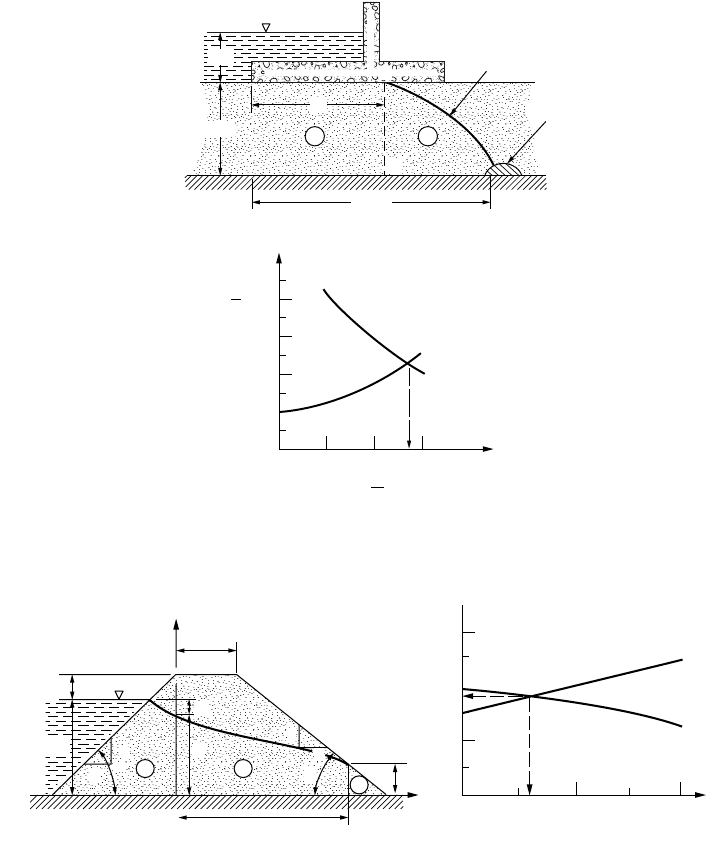
18-18 The Civil Engineering Handbook, Second Edition
With tailwater absent, h
2
= 0, the flow in region 3, a type IX fragment, with cot b = 3 produces
(18.33)
Finally, from the geometry of the section, we have
(18.34)
The four independent equations contain only the four unknowns, h, a
2
, Q/k, and L, and hence provide
a complete, if not explicit, solution.
FIGURE 18.18 Example 18.5.
FIGURE 18.19 Example 18.6.
Free surface
Drain
25 ft
12
0 0.5 1.0 1.5
8
6
4
2
(
Q
/
k
)
1
(
Q
/
k
)
2
B
=14 ft
Q
k
B
T
8 ft
10 ft
B
C
A
(
a
)
(
b
)
y
b
=
20 ft
10 ft
h
1
= 70 ft
(
a
)(
b
)
L
3
a
2
a
2
= 18.3 ft
a
2
h
x
50
30
h
= 52.7 ft
Eq. (17.38)
Eq. (17.36)
20
10
0
55 60
1
1
2
3
1
3
a
1
h
b
a
Q
k
----
a
2
3
----=
L 20
b
cot h
d
a
2
–[]+ 20 3 80 a
2
–[]+==
© 2003 by CRC Press LLC
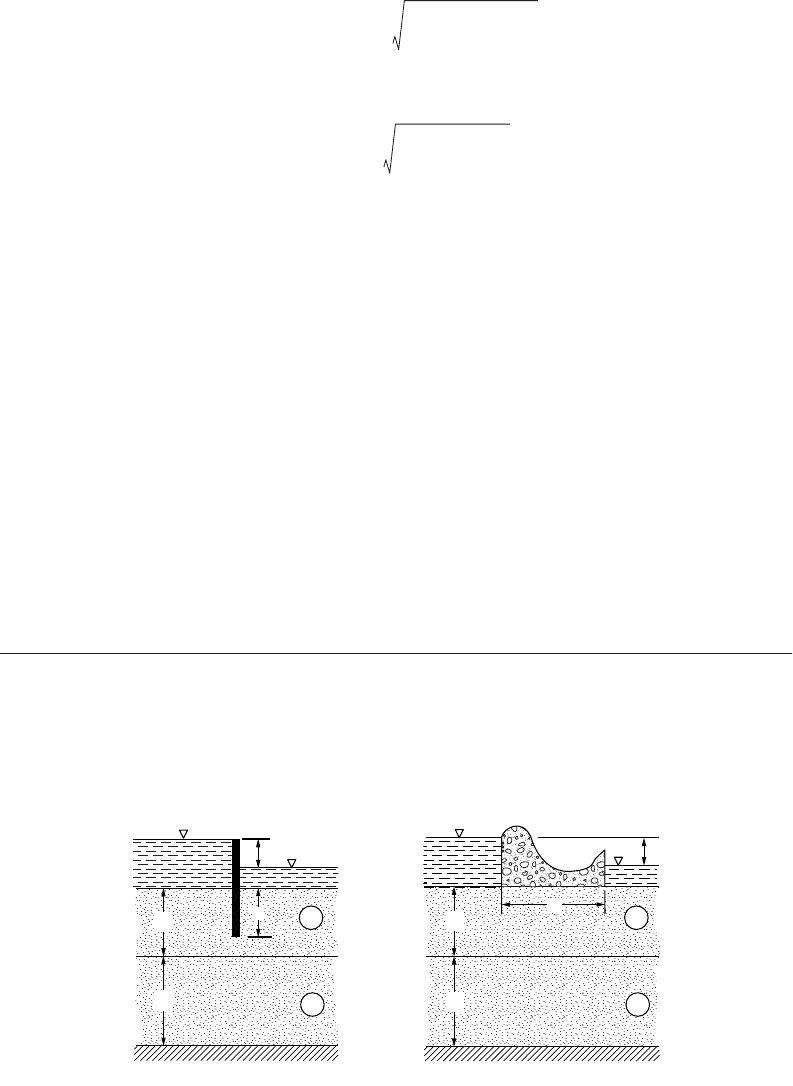
Groundwater and Seepage 18-19
Combining Eqs. (18.32) and (18.33) and substituting for L in Eq. (18.34), we obtain, in general (b =
crest width),
(18.35)
and, in particular,
(18.36)
Likewise, from Eqs. (18.31) and (18.33), in general,
(18.37)
and, in particular,
(18.38)
Now, Eqs. (18.36) and (18.38), and (18.35) and (18.37) in general, contain only two unknowns (a
2
and h),
and hence can be solved without difficulty. For selected values of h, resulting values of a
2
are plotted for
Eqs. (18.36) and (18.38) in Fig. 18.19(b). Thus, a
2
= 18.3 ft, h = 52.7 ft, and L = 205.1 ft. From Eq. (18.33),
the quantity of flow per 100 ft is
18.5 Flow in Layered Systems
Closed-form solutions for the flow characteristics of even simple structures founded in layered media
offer considerable mathematical difficulty. Polubarinova-Kochina [1962] obtained closed-form solutions
for the two layered sections shown in Fig. 18.20 (with d
1
= d
2
). In her solution she found a cluster of
parameters that suggested to Harr [1962] an approximate procedure whereby the flow characteristics of
structures founded in layered systems can be obtained simply and with a great degree of reliability.
FIGURE 18.20 Examples of two-layered systems.
a
2
b
b
cot
------------ h
d
b
b
cot
------------ h
d
+
˯
ʈ
2
h
2
––+=
a
2
20
3
----- 80
20
3
----- 80+
˯
ʈ
2
h
2
–+=
a
2
a
cot
b
cot
------------------ h
1
h–()
h
d
h
d
h–
--------------
ln=
a
2
70 h–()
80
80 h–
--------------
ln=
Q 100 2 10
3–
18.3
3
----------
¥¥¥ 1.22 ft
3
min§ 9.1 gal min§===
h
h
k
2
k
1
k
2
k
1
B
d
1
d
2
d
1
d
2
s
(
a
)(
b
)
© 2003 by CRC Press LLC
